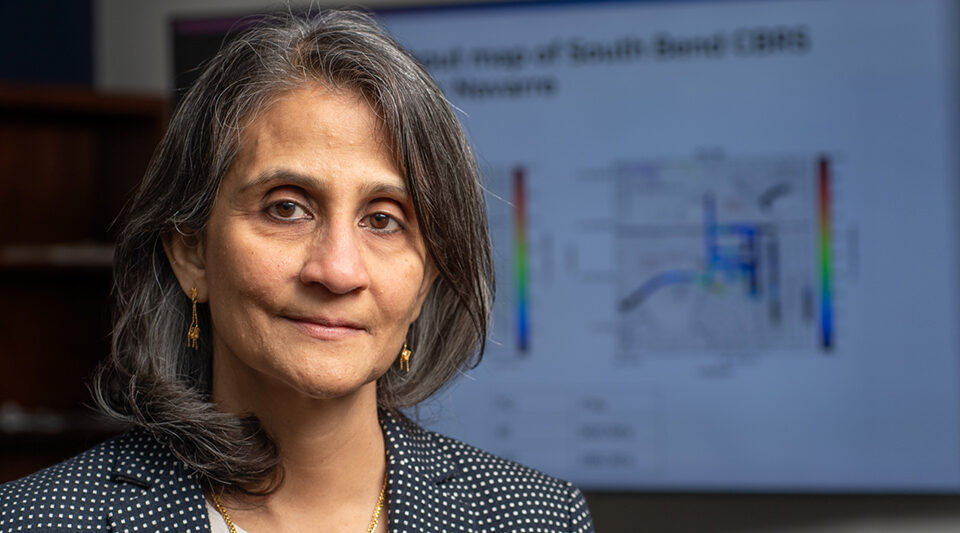Monisha Ghosh, professor of electrical engineering and an affiliate member of the Wireless Institute at the University of Notre Dame, testified on Thursday (March 21) before the U.S. Senate Committee on Commerce, Science, and Transportation on the topic of “Spectrum and National Security.”
The hearing, chaired by U.S. Sen. Maria Cantwell of Washington, focused on the critical need for a “coordinated and comprehensive approach to domestic spectrum policy,” believed to be critical to U.S. national security. The committee sought opinions from experts on countering international threats and ways to ensure “the United States leads in spectrum use policy that protects the nation’s critical national security and economic competitiveness missions.”
Increased reliance on and use of spectrum — radio frequencies used for everything from mobile broadband to GPS navigation as well as satellite and defense applications — have raised questions about how to manage what is a key natural resource efficiently and effectively.
Ghosh stressed the need for policies that enhance national security through sustainable allocation of spectrum. Those policies, she said, must balance the current and future needs of the commercial wireless sector, scientific applications and mission-critical federal operations including radar used for defense, weather, aviation, GPS navigation and satellite systems.
“The U.S. leads the world today in innovations in spectrum policy that have delivered wireless applications that impact all aspects of our life, from broadband connectivity to national security and scientific breakthroughs,” Ghosh said in her written testimony. “This leadership must continue to ensure that all options are evaluated to create a sustainable spectrum strategy for every system that requires access to spectrum.”
Ghosh is an expert in spectrum sharing and coexistence, wireless networks, signal processing, wireless broadband mapping, measurements and experimental methods. Before coming to Notre Dame, she served as chief technology officer at the Federal Communications Commission, developing strategies in response to explosive growth of broadband wireless communications technologies.
In addition to her faculty position, Ghosh serves as policy outreach coordinator for SpectrumX, a National Science Foundation Spectrum Innovation Initiative Center led by Notre Dame’s Wireless Institute. The center is a collaboration of experts from more than four dozen academic institutions, businesses and government organizations working to transform the landscape of spectrum research, education, collaboration and management.
Ghosh also emphasized the need for dynamic spectrum sharing (DSS) — a practice allowing both government and private users to access the same frequency at the same time while protecting primary users from potentially harmful interference.
According to the National Telecommunications and Information Administration, DSS has been used by the Citizens Broadband Radio Service, a multi-tiered licensing framework through which federal and non-federal entities access the same band of radio frequency at 3.5 GHz. “While the government isn’t using the airwaves, companies and the public can gain access through a tiered licensing arrangement,” the NTIA has said.
“Dynamic spectrum sharing is a key technological innovation that was conceived of and first implemented in the U.S.,” Ghosh wrote in her testimony. “However, we must continue the innovations to ensure that both policies and technologies lead to the development of a truly sharing-native wireless ecosystem that continues to serve all needs.”
Before concluding, Ghosh urged the committee to consider the need for long-term spectrum research and development.
“The U.S. has always led the world in spectrum policy and technology innovations,” she said. “I’m confident that the actions of this committee and the all-of-government approach outlined in the National Spectrum Strategy will solidify our position.”
On April 19, Notre Dame celebrates 125 years of wireless innovation and research this year: The University conducted the first long-distance wireless transmission in North America in 1899. Those early experiments have led to numerous technology and application developments in wireless that now require careful deliberation when it comes to allocating radio spectrum for certain uses. Through research at the Wireless Institute and SpectrumX, Notre Dame continues to be at the forefront of wireless innovation. For additional information on the 125 Years of Wireless Innovation at Notre Dame celebration: https://wireless.nd.edu/125-years/.
Contact: Jessica Sieff, associate director of media relations, 574-631-3933, jsieff@nd.edu
